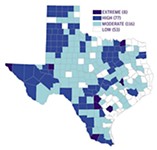Regional Planning
Like herding counties
By Katherine Gregor, Fri., April 9, 2010

"There's no free money," said Betty Dunkerley at a recent forum for Envision Central Texas. No matter what the funding mechanism for roads or transit or a water treatment plant, she continued, "It all comes from us – the citizens."
About 300 community leaders from five counties paid $50 each to attend the regional forum. Called "More People. Less Money. What Now?," the March 31 event was the first of four in ECT's 2010 series. Participants heard a common message from about two dozen speakers: With federal, state, and private funding for needed infrastructure scarce, it has become critical that Central Texas cities and counties collaborate on planning and funding a sustainable future.
The economic angle provided a fresh take on an entrenched Central Texas dilemma, described by Lower Colorado River Authority General Manager Tom Mason as getting "people to work in concert toward a common goal." For example, he said, the region will benefit if all of LCRA's regulatory partners agree on the same set of water-conservation rules for outdoor watering, "so they're not played off each other." To fund long-term assets such as toll roads and transit systems, said panelist Jim Ziglar of Deloitte Corporate Finance, it's worth exploring the benefits of public-private partnerships in which "the public always retains ownership, so they can hold the private side's feet to the fire."
In answer to an electronic poll, participants identified three primary roadblocks to regional problem-solving, particularly for water and transportation/transit: 1) lack of common goals and objectives among Central Texas jurisdictions, 2) competing funding priorities, and 3) lack of regional thinking. Those were the very problems ECT formed to help solve in 2001. The nonprofit worked to develop a common vision for Central Texas, presented in 2004. Since then, however, no leader or effective regional coalition has emerged to implement ECT's preferred growth scenario for development patterns that combine greater density with conserved open space.
In effect, the forum ratified a failure by regional elected officials, leaders, and entities – including ECT – to forge unity in planning holistically for growth. It's everybody's problem but nobody's job. Meanwhile, according to ECT, the population in Bastrop, Caldwell, Hays, Travis, and Williamson counties has grown to more than 1.7 million; by 2030, Central Texas is projected to have more than 3 million residents.
Participants made near-term recommendations for improving the "efficiency and coordination of infrastructure" in the next 18 months. Popular themes: One leader (perhaps the city of Austin, perhaps a merger of the Capital Area Metropolitan Planning Organization and Capital Area Council of Governments) needs authority to bring all Central Texas governing bodies together and broker solutions, and the Legislature needs to expand county land-use authority and allow local-option funding (e.g., an increment added to the state gas tax) that would channel money directly to regional projects.
On Sept. 10, ECT hosts a follow-up forum to continue advancing the infrastructure discussion. A summary of the March forum, with recommendations for short-term action steps, will be posted later this month at www.envisioncentraltexas.org.
Got something to say on the subject? Send a letter to the editor.










